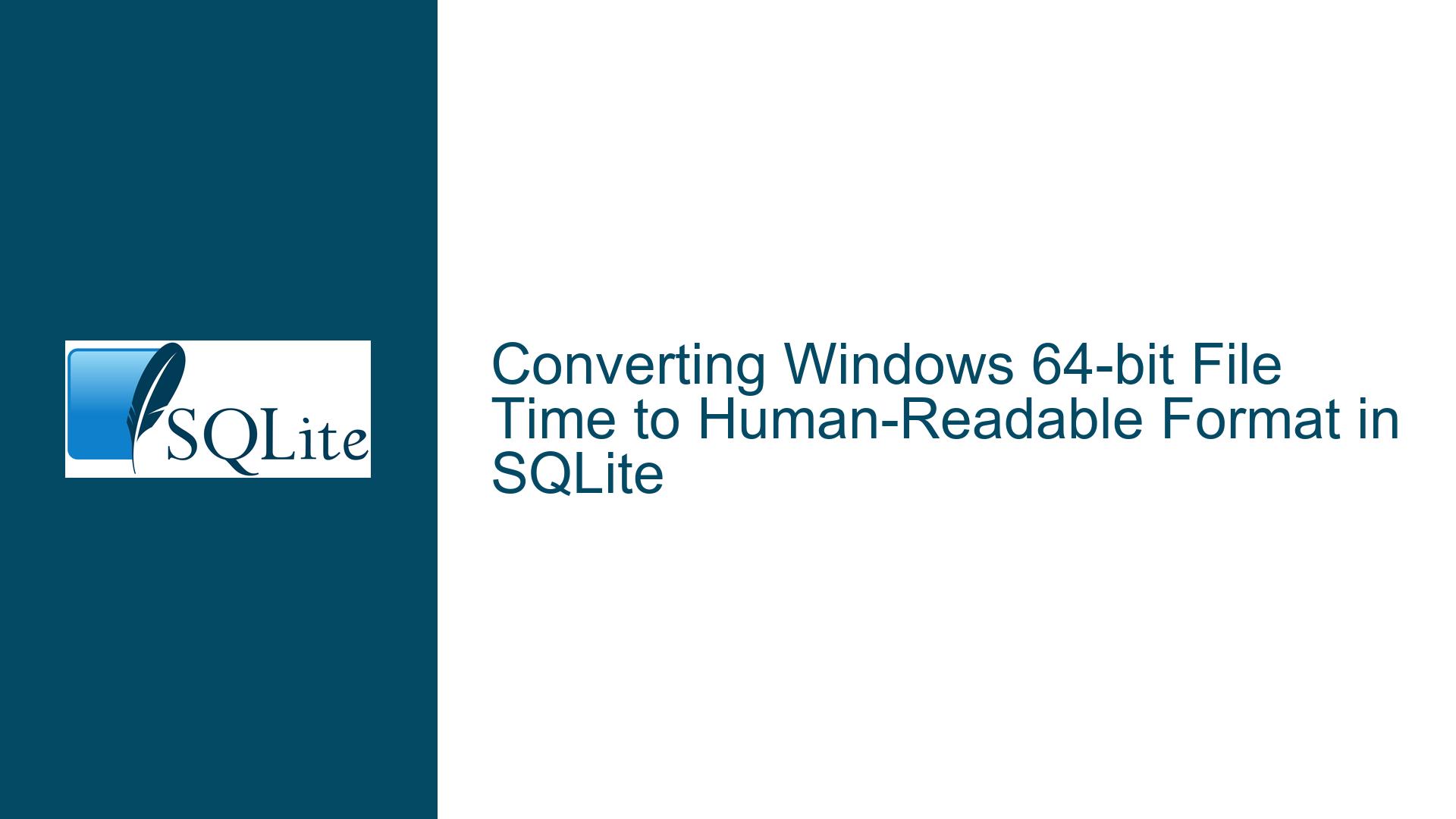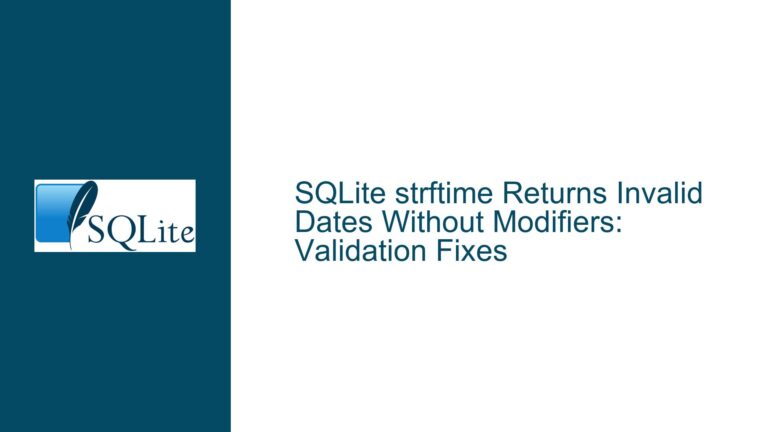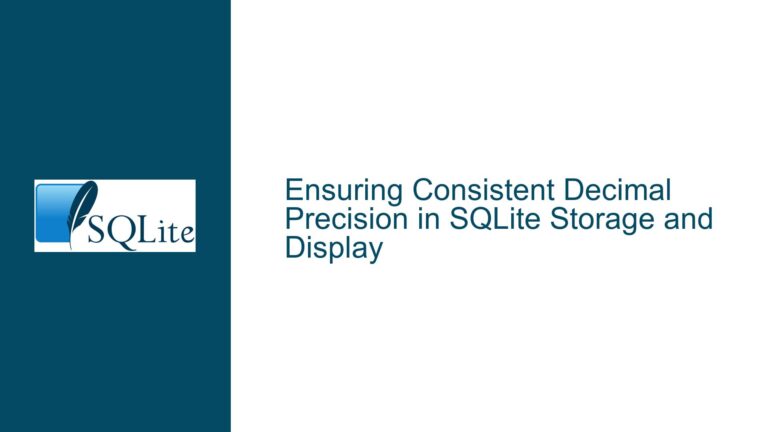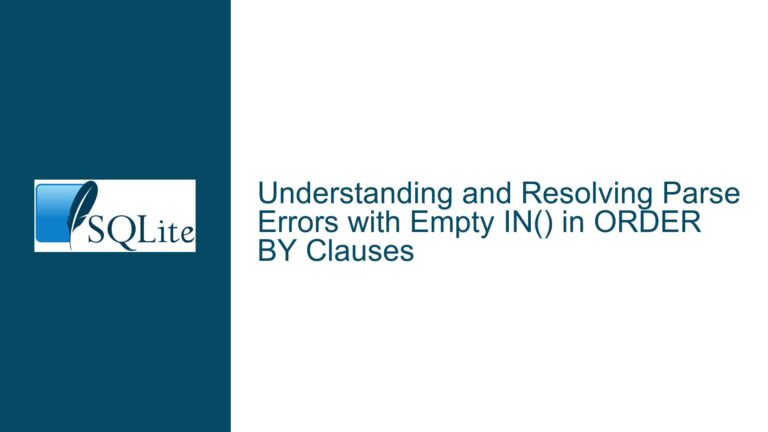Converting Windows 64-bit File Time to Human-Readable Format in SQLite
Understanding Windows 64-bit File Time and Its Conversion Challenges
Windows 64-bit file time is a system for representing time in 100-nanosecond intervals since January 1, 1601 (UTC). This format is used internally by Windows to track file creation, modification, and access times. The challenge arises when you need to convert this high-precision time format into a human-readable date and time representation, especially in SQLite, which does not natively support Windows file time. Additionally, the conversion must be bidirectional, meaning you should be able to convert the human-readable format back to the original 64-bit value without losing precision.
The core issue revolves around the fact that SQLite’s datetime function is designed to work with Unix epoch time (seconds since January 1, 1970) and does not natively handle the nanosecond precision required for Windows file time. Furthermore, the conversion process must account for the difference in epochs between Windows (1601) and Unix (1970), which is 11644473600 seconds. This discrepancy complicates the conversion, as you must adjust for this offset while preserving the nanosecond precision.
The discussion highlights several attempts to address this issue, including dividing the Windows file time by 10,000,000 to convert it to seconds and then using SQLite’s datetime function to generate a human-readable format. However, these attempts often fail to preserve the nanosecond part of the time or introduce inaccuracies due to rounding errors. The goal is to achieve a precise and reversible conversion that maintains the integrity of the original 64-bit value.
Potential Causes of Conversion Errors and Precision Loss
Several factors contribute to the difficulty of accurately converting Windows 64-bit file time to a human-readable format in SQLite. One major cause is the inherent limitation of SQLite’s datetime function, which only supports second-level precision. This means that any attempt to convert a time value with nanosecond precision will result in the loss of the fractional seconds unless additional steps are taken to preserve them.
Another cause of errors is the difference in epochs between Windows and Unix systems. Windows file time starts counting from January 1, 1601, while Unix time starts from January 1, 1970. This 369-year difference must be accounted for during the conversion process. Failing to adjust for this offset will result in incorrect date and time values. Additionally, the conversion process must handle the transition between the two epochs carefully to avoid overflow or underflow errors, especially when dealing with large 64-bit values.
Rounding errors are another common issue. When dividing the Windows file time by 10,000,000 to convert it to seconds, any remainder represents the fractional seconds (nanoseconds). If this remainder is not properly handled, it will be lost during the conversion. Similarly, when converting back from a human-readable format to the original 64-bit value, any fractional seconds must be accurately extracted and recombined with the integer seconds to reconstruct the original value.
Finally, the lack of native support for high-precision time formats in SQLite means that developers must rely on custom SQL queries and string manipulation to achieve the desired results. This approach is error-prone and can lead to inconsistencies if not implemented carefully. For example, using string concatenation to append fractional seconds to a datetime string can introduce formatting issues or rounding errors if the number of digits is not consistent.
Step-by-Step Solutions for Accurate Conversion and Preservation of Precision
To achieve accurate and reversible conversion between Windows 64-bit file time and a human-readable format in SQLite, follow these steps:
Step 1: Convert Windows File Time to Unix Epoch Time
The first step is to convert the Windows file time to Unix epoch time. This involves dividing the 64-bit value by 10,000,000 to convert it to seconds and then subtracting the epoch difference (11644473600 seconds) to adjust for the difference between the Windows and Unix epochs. The following SQL query demonstrates this process:
SELECT (132061681346589253 / 10000000) - 11644473600 AS unix_epoch_time;
This query converts the Windows file time 132061681346589253 to Unix epoch time. The result is the number of seconds since January 1, 1970.
Step 2: Generate a Human-Readable Date and Time String
Once the Unix epoch time is obtained, use SQLite’s datetime function to generate a human-readable date and time string. To preserve the fractional seconds (nanoseconds), extract the remainder from the division operation in Step 1 and append it to the datetime string. The following query demonstrates this:
SELECT datetime((132061681346589253 / 10000000) - 11644473600, 'unixepoch', 'localtime') || '.' || (132061681346589253 % 10000000) AS readable_time;
This query produces a datetime string in the format YYYY-MM-DD HH:MM:SS.nnnnnnn, where nnnnnnn represents the fractional seconds. For example, the output might be 2019-06-28 06:02:14.6589253.
Step 3: Convert Back to the Original 64-bit Value
To convert the human-readable datetime string back to the original 64-bit Windows file time, reverse the process. First, extract the integer seconds and fractional seconds from the datetime string. Then, add the epoch difference and multiply by 10,000,000 to convert back to 100-nanosecond intervals. The following query demonstrates this:
SELECT 10000000 * (11644473600 + cast(strftime('%s', '2019-06-28 06:02:14') AS integer)) + cast(1e7 * cast('0.6589253' AS real) AS integer) AS original_file_time;
This query reconstructs the original 64-bit Windows file time from the human-readable datetime string. The strftime function extracts the integer seconds, and the fractional seconds are converted back to 100-nanosecond intervals.
Step 4: Store the Original Value and Presentation Format
To avoid repeated conversions, store the original 64-bit Windows file time in the database and use a computed column to generate the human-readable format. This approach ensures that the original value is preserved while providing a convenient way to display the time in a user-friendly format. The following SQL statement demonstrates this:
CREATE TABLE file_times (
file_time INTEGER NOT NULL,
readable_time TEXT GENERATED ALWAYS AS (
datetime((file_time / 10000000) - 11644473600, 'unixepoch', 'localtime') || '.' || (file_time % 10000000)
) STORED
);
This table stores the original 64-bit Windows file time and automatically generates the human-readable format as a computed column. The readable_time column is updated whenever the file_time column changes, ensuring consistency between the two representations.
Step 5: Handle Edge Cases and Validation
Finally, validate the conversion process to ensure accuracy and handle edge cases. For example, test the conversion with the minimum and maximum values of Windows file time to ensure that the process works correctly across the entire range. Additionally, verify that the fractional seconds are preserved during the conversion and that the reconstructed 64-bit value matches the original input.
By following these steps, you can achieve accurate and reversible conversion between Windows 64-bit file time and a human-readable format in SQLite. This approach preserves the precision of the original value while providing a user-friendly representation for display purposes.






